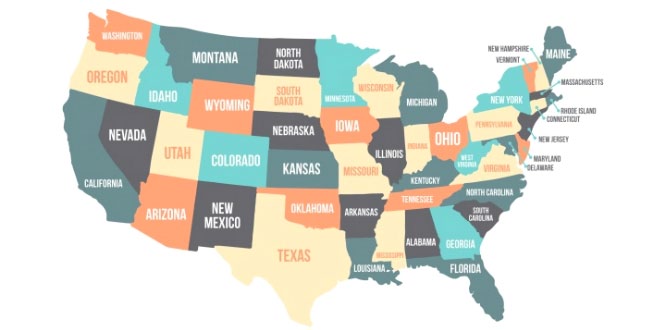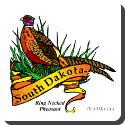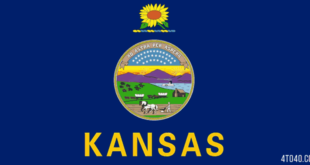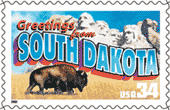 Dakota is a Sioux word meaning “alliance of friends.” The state’s nicknames include the “Sunshine State” and the “Coyote State.” The territory was explored by the French in the mid-18th century, and settlement began in 1857. On Nov. 2, 1889, South Dakota became the 40th state in the Union. South Dakota has traditionally been an agricultural state, but recently it has become a major tourist center and has also experienced commercial and industrial growth.
Dakota is a Sioux word meaning “alliance of friends.” The state’s nicknames include the “Sunshine State” and the “Coyote State.” The territory was explored by the French in the mid-18th century, and settlement began in 1857. On Nov. 2, 1889, South Dakota became the 40th state in the Union. South Dakota has traditionally been an agricultural state, but recently it has become a major tourist center and has also experienced commercial and industrial growth.
South Dakota State: Land & Resources
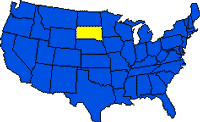 The South Dakota State is divided in half by the north-south-flowing Missouri River, which was formed when glaciers to the east blocked the flow of western rivers, forcing them southward. It runs through a channel about 90 to 150 m (300 to 500 ft) below the surface of the surrounding plain. The state’s elevation averages 670 m (2,200 ft).
The South Dakota State is divided in half by the north-south-flowing Missouri River, which was formed when glaciers to the east blocked the flow of western rivers, forcing them southward. It runs through a channel about 90 to 150 m (300 to 500 ft) below the surface of the surrounding plain. The state’s elevation averages 670 m (2,200 ft).
Glaciated eastern South Dakota State is known as Prairie Country. The melted ice left the land covered with glacial debris, resulting in low rolling hills, marshy areas and small lakes, and shallow river valleys. The eastern part of the state is covered with rich chernozem prairie soils.
Unglaciated western South Dakota State is part of the GREAT PLAINS. It is composed of smooth hills, isolated buttes, and flat dissected plateaus. Fertile chestnut brown soils cover the drier plains. The beautiful, castellated BADLANDS follow the White River, in the southern part of the state.
The BLACK HILLS form a third topographic region in the southwest corner of South Dakota. They are a domed mountain region composed of an ancient crystalline core with deep valleys, surrounded by ridges of sedimentary strata. The state’s highest point, Harney Peak (2,207 m/7,242 ft), is located in the Black Hills. Thin, infertile grey wooded soils are found there.
Climate
The climate is continental with distinct seasons. Great extremes in diurnal and yearly temperatures can occur, modified by low humidity, moderate winds, and low precipitation. In January temperatures average from -12 deg to -7 deg C (10 deg to 20 deg F) in the north and between -7 deg and -4 deg C (20 deg and 24 deg F) in the south. In July temperatures range from 18 deg to 21 deg C (65 deg to 70 deg F) in the north, and between 21 deg and 24 deg C (70 deg and 75 deg F) in the south. Precipitation varies from 660 mm (26 in) in the southeast to 330 mm (13 in) in the northwest. Over two-thirds of the precipitation falls during the 130-day average growing season. The state can experience blizzards during winter and severe thunderstorms and tornadoes in spring and summer.
The MISSOURI RIVER, which flows into the Mississippi River and then to the Gulf of Mexico, receives drainage from all regions but northeastern South Dakota, which drains into the Hudson Bay. Principal eastern streams are the Big Sioux, Vermillion, and James rivers. The major western streams are the Grand, Moreau, Cheyenne, Bad, White, and Keya Paha rivers. The two largest natural lakes are Big Stone and Traverse, both in the northeast; the many large artificial lakes include Lake Oahe.
Tourism
Historic sites include Deadwood, an old mining town that included figures like Calamity Jane and Wild Bill Hickok among its residents; Yankton, the state’s first white settlement; Fort Pierre, site of the earliest trading post; and the WOUNDED KNEE Battlefield, located near Pine Ridge in the Oglala Sioux Indian reservation. Mount RUSHMORE is a national memorial in the Black Hills. National parks include Badlands and Wind Cave (limestone caverns located in the Black Hills). Recreational activities–hunting, fishing, camping, boating, skiing, and skating–take place in South Dakota’s national parks and major state recreation areas.
South Dakota State: History
Evidence indicates the presence of hunters in South Dakota as early as 7,000 years ago. About AD 500 the MOUND BUILDERS appeared along the Big Sioux River. By 1250 settlers who may have been the forebears of the ARIKARA tribe arrived, constructing fortresses with a capacity to contain up to 5,000 people, along the Missouri River. By the 16th century, the Arikara inhabited the area. Their fortified villages served as centers for agriculture, horse trading, military, and tribal organization.
The territory was explored (1742-43) by the brothers Francois and Louis Joseph LA VERENDRYE, who claimed the land for France. In 1762, France ceded the area (which was part of the huge territory called Louisiana) to Spain, and thereafter both the SIOUX Indians and European fur traders began filtering into the territory. The Sioux, changing from a sedentary to a hunting existence, pushed the Arikara westward. This conflict, as well as susceptibility to European diseases, caused the downfall of the Arikara.
In 1803 the United States acquired the area as part of the LOUISIANA PURCHASE. Trading posts such as Fort Pierre (established 1817) prospered with the fur trade. The first permanent European settlement was at Yankton in 1859, following a treaty with the Yankton Sioux. In 1862, Yankton became the capital of the newly established Dakota Territory. In the next decade settlements were established along the Missouri River and its tributaries, and the number of settlements increased rapidly with the coming of the railroad in the 1870s.
In 1874, Gen. George CUSTER led an exploratory expedition into the Black Hills, discovering gold. With the resultant influx of settlers, new towns such as Deadwood were established. With new settlers, conflicts with the Sioux intensified, as much of the land had previously been granted to the Sioux by treaty. Although General Custer and his troops were defeated (1876) at the Battle of the LITTLE BIGHORN, Indian resistance was finally crushed (1890) with the massacre at Wounded Knee (1890). Since then, the Indian population has primarily resided on the nine reservations in South Dakota. In 1973, as a means of drawing attention to Sioux grievances, some 200 armed Indians occupied Wounded Knee for 70 days.
With the opening of land to homesteading, the population increased to 281,000 by 1890; the lands east of the Missouri were settled mostly by northern Europeans. Pressure for statehood ensued, but the movement was delayed by the Democrats in Washington who were reluctant to add another predominantly Republican state. North and South Dakota finally became states simultaneously on Nov. 2, 1889.
Under the governorship of Peter Norbeck (1917-21) constitutional amendments sponsored by the Progressive wing of the Republican party enabled the state government to become involved in various commercial enterprises such as railroad rates regulation, coal mining, insurance, and credit. With the exception of the state cement plant, these failed dismally and left South Dakota deeply in debt by the mid-1920s. These failures combined with the Depression and the Dust Bowl droughts of 1933 and 1934 to put the state into a financial crisis that was not resolved until 1946. By 1933 one farm in every ten was lost by foreclosure or tax sale. After World War II, however, this rate changed to one in every 1,000.
Since World War II the state has progressed, building a strong agricultural base on which to develop expanding tourism, industry, and commerce. Despite these developments, the state’s Indian reservation residents have not kept pace and have continued to suffer a very high unemployment rate. That and the troublesome issue of tribal jurisdiction created incidents of racial conflict and other problems for the state in the 1980s and early 1990s.
South Dakota State: Land
- Area: 199,743 sq km (77,121 sq mi); rank: 17th.
- Capital: Pierre (1990 census, 12,906).
- Largest city: Sioux Falls (1990 census, 100,814).
- Counties: 66.
- Elevations: highest–2,207 m (7,242 ft), at Harney Peak; lowest–294 m (966 ft), at Big Stone Lake.
 Kids Portal For Parents India Kids Network
Kids Portal For Parents India Kids Network
